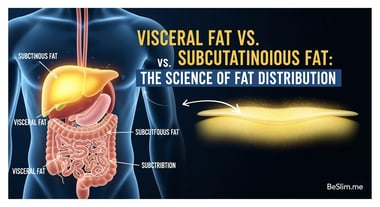Hello, I'm Master Kim, the founder and Chief Scientific Officer at BeSlim.me. As someone who's dedicated years to understanding the complexities of weight management through both personal experience and scientific research, I know how overwhelming it can feel when genetics seem to play a role in obesity. If you've ever wondered why some people struggle more with weight despite similar lifestyles, this guide is for you. We'll explore the differences between monogenic and polygenic obesity, shedding light on their genetic roots. My goal is to empower you with knowledge so you can make informed decisions about your health journey. Let's dive into the science behind this.
Understanding the Basics of Genetic Influences on Obesity
Obesity is not just a matter of diet and exercise; genetics can significantly influence an individual's predisposition to weight gain. Genetic factors contribute to obesity by affecting how the body regulates energy balance, appetite, and metabolism. Broadly, these genetic causes are categorized into monogenic and polygenic forms. Monogenic obesity arises from mutations in a single gene, leading to severe, early-onset weight issues. In contrast, polygenic obesity involves multiple genes interacting with environmental factors, resulting in a more common, gradual form of obesity.
To grasp these concepts, it's essential to understand the role of genes in body weight regulation. Genes encode proteins that participate in critical pathways, such as those controlling hunger signals in the brain or fat storage in cells. When these genes are altered, it can disrupt homeostasis, making weight management challenging.
A simple comparison table here would enhance understanding: one column for monogenic obesity (e.g., single gene mutation, rare, severe) and another for polygenic (e.g., multiple genes, common, influenced by lifestyle). This visual aid could quickly highlight key differences before delving deeper.
The mechanism behind genetic obesity often involves disruptions in leptin signaling, a hormone produced by fat cells that signals satiety to the brain. In genetic forms, mutations can impair this pathway, leading to overeating or reduced energy expenditure.
Exploring Monogenic Obesity: Single-Gene Mutations and Mechanisms
Monogenic obesity is characterized by mutations in a single gene that profoundly impact body weight regulation, often resulting in extreme obesity from a young age. These conditions are rare, affecting less than 1% of the obese population, but they provide valuable insights into the biological underpinnings of weight control.
The primary mechanism in monogenic obesity revolves around defects in the leptin-melanocortin pathway, a critical cell signaling system in the hypothalamus that regulates appetite and energy balance. Leptin, secreted by adipose tissue, binds to receptors in the brain, activating pro-opiomelanocortin (POMC) neurons. These neurons release melanocortin peptides, which bind to melanocortin-4 receptors (MC4R) to suppress hunger and increase energy expenditure. A mutation in genes like LEP (encoding leptin) or MC4R disrupts this cascade, leading to unchecked appetite and reduced metabolic rate.
For instance, in leptin deficiency, caused by mutations in the LEP gene, the absence of functional leptin fails to inhibit hunger signals, resulting in hyperphagia (excessive eating) and rapid weight gain. This is evident in conditions like congenital leptin deficiency, where affected individuals exhibit severe obesity by infancy. The biological reasoning is rooted in impaired negative feedback: without leptin, the brain perceives a state of starvation, prompting increased food intake and fat storage to conserve energy.
Another example is mutations in the MC4R gene, the most common cause of monogenic obesity. These mutations reduce receptor sensitivity, weakening the anorexigenic (appetite-suppressing) signals. Consequently, energy homeostasis tilts toward fat accumulation, as the body fails to burn calories efficiently. Research supports that such mutations can increase body mass index (BMI) significantly, with affected individuals often requiring specialized interventions like hormone replacement.
According to studies, mutations in the MC4R gene account for up to 5-6% of severe early-onset obesity cases, highlighting the gene's pivotal role in energy regulation. This citation underscores the direct link between single-gene defects and profound metabolic disruptions.
A diagram illustrating the leptin-melanocortin pathway would be beneficial here, showing normal signaling versus mutated versions with arrows indicating disrupted steps. This visual could clarify how a single mutation cascades into obesity.
Delving into Polygenic Obesity: Multiple Genes and Environmental Interactions
Polygenic obesity, unlike its monogenic counterpart, results from the cumulative effects of numerous genetic variants, each contributing a small risk to weight gain. This form is far more prevalent, underlying most cases of common obesity, and is influenced heavily by lifestyle and environmental factors.
The underlying mechanism involves polygenic risk scores (PRS), where variants in hundreds of genes subtly alter pathways related to appetite, fat metabolism, and insulin sensitivity. These genes often affect hypothalamic regulation, similar to monogenic forms, but through additive effects rather than a single dominant mutation. For example, variants in genes like FTO (fat mass and obesity-associated gene) influence dopamine signaling in the brain's reward system, increasing the preference for high-calorie foods and reducing satiety.
Biologically, polygenic obesity disrupts multiple hormone actions and cell signaling networks. Insulin, a key hormone in glucose and fat metabolism, can be affected by variants in genes like TCF7L2, leading to impaired insulin secretion or resistance. This results in inefficient energy storage and utilization, promoting fat accumulation. Additionally, gut hormones like ghrelin (which stimulates hunger) and peptide YY (which promotes fullness) may have altered signaling due to polygenic variations, creating a predisposition to overeating in calorie-rich environments.
The "why" behind this is evolutionary: many of these genetic variants likely provided survival advantages in times of food scarcity by enhancing fat storage efficiency. However, in modern environments with abundant food, they contribute to obesity. Genome-wide association studies (GWAS) have identified over 1,000 loci associated with BMI, each with minor effects that compound.
Evidence shows that polygenic risk scores can predict obesity risk, with higher scores correlating to increased BMI in diverse populations, emphasizing the multifactorial nature. This interaction between genes and environment explains why not everyone with a high PRS develops obesity—lifestyle modulates the outcome.
Comparing Monogenic and Polygenic Obesity: Implications and Actionable Insights
When comparing monogenic and polygenic obesity, the key distinctions lie in prevalence, severity, and treatability. Monogenic forms are rare, often syndromic (accompanied by other symptoms like developmental delays), and driven by high-impact single mutations, leading to extreme obesity resistant to standard interventions. Polygenic obesity is common, with milder effects from many low-impact variants, making it more responsive to lifestyle changes.
Mechanistically, both involve disruptions in similar pathways—such as leptin and insulin signaling—but monogenic cases feature complete pathway breakdowns, while polygenic ones involve subtle inefficiencies amplified by external factors. This comparison reveals why genetic testing can be crucial: for monogenic obesity, targeted therapies like leptin analogs may be effective, whereas polygenic cases benefit from broad strategies like diet and exercise.
Research indicates that genetic factors contribute to 40-70% of BMI variation, with monogenic forms being identifiable through sequencing, aiding in personalized medicine approaches.
Now, shifting back to you—based on my experience at BeSlim.me, here are some actionable takeaways to apply this knowledge:
- Get Genetic Insights: If you suspect a strong family history of severe obesity, consult a healthcare provider for genetic testing. Early detection of monogenic forms can lead to specialized treatments.
- Focus on Modifiable Factors: For polygenic predispositions, prioritize a balanced diet and regular physical activity. Aim for 150 minutes of moderate exercise weekly to counteract genetic risks.
- Monitor Hormonal Health: Track appetite cues and consider professional advice on hormone levels, especially if weight gain feels uncontrollable.
- Seek Personalized Support: At BeSlim.me, we offer tailored programs that integrate genetic understanding with practical strategies—reach out if you'd like to explore options.
By understanding these genetic causes, you're better equipped to navigate your path to better health. Remember, genetics are just one piece; your actions can make a profound difference.
References
- Mutations in the MC4R gene account for up to 5-6% of severe early-onset obesity cases
- Polygenic risk scores can predict obesity risk, with higher scores correlating to increased BMI in diverse populations
- Genetic factors contribute to 40-70% of BMI variation, with monogenic forms being identifiable through sequencing
Medical Disclaimer
The content on this website is for informational and educational purposes only. It is not intended as medical advice and should not be relied upon as a substitute for consultations with qualified healthcare professionals who are familiar with your individual medical needs. Always seek the advice of your physician or other qualified healthcare provider with any questions you may have regarding a medical condition. Never disregard professional medical advice or delay in seeking it because of something you have read on this website.





Comments (0)
No comments yet. Be the first to comment!